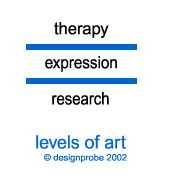|
 |
designprobe Design Research
At designprobe our research includes both ‘research about design’ and ‘design research’ with a particular focus upon creating artifacts through creating art. If you looked at what we do this may appear to be similar to the work of the majority of artists. We do create paintings and sculptures, however, we also claim the intent behind our work is different.
 Art Art
To explain this in a simple way, we have identified three distinct
levels or approaches to art.
- ART AS THERAPY: Art is a vehicle for an emotional connection,
release or exploration by the artist.
- ART AS EXPRESSION: The artist starts with an idea and the
artwork illustrates the idea. This is perhaps the most common
way in which art is produced. Typically, artists working in
this way are content to express their ideas inside traditional
and agreed conventions for representing images and forms.
- ART AS RESEARCH: The artist intends to explore the nature
of how the art is perceived through the construction or creation
of a visual language. The great hope of these artists to create
new modes of representation of images and forms.
Visual Language
It is generally agreed by scientists (and psychologists) that
our visual world is a mental construct. We see the world not how
it is, but how it appears to us as an individual observer. In terms
of art, this raises the question ‘How does one view a painting?’
At one level, the paint on the surface of the canvas is relatively
fixed yet each person who views it sees something slightly different.
One thing that can be seen is the paint (and often we forget to
notice this) and the other is any image that we might recognize
within the painting.
This relationship between the paint and any images that occur is
the basis for a visual language. A useful question to ask to expose
the visual language that occurs in a painting is: ‘How do the
paint marks form that image for me?’
As a particular way of painting is used repeatedly it may be adopted
as the way to represent an object(s). For example, we can talk about
the perspective modelling system as the way that images were constructed
by painters during the Renaissance and beyond. In contrast, Cubism
offers an alternative way to construct the world.
The most common visual language is our alphabet. Consider… if you are reading these words you have learnt to read a visual language. If you didn’t know how to read these words, the letters on this page would be meaningless scribbles, which may be how some paintings or foreign languages look to you.
In very simple terms, the nature of art as research is the process of creating new additions to our visual language. This is not an easy task. It ranks with the work of inventors creating something that has never before existed. (See Levels of Creation for more on Inventing). This operates at both a two-dimensional level, as in a visual image, and in the three-dimensional level, as in the form or shape of an object.
At designprobe, our design research focuses at this level of creating both 2D and 3D visual language structures. As a research centre our intention is to create new language structures that will lead to the creation of new opportunities for design and technology.
|
 |
| |
|
|

|
|

![]()
